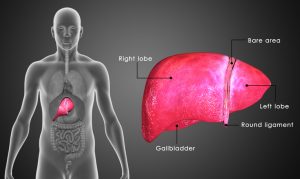 Non-alcoholic fatty liver disease (NAFLD) progression to fibrosis and cirrhosis can be identified by a novel method combining multiple non-invasive measures. NAFLD develops when fat accumulates in the liver. It is estimated that roughly 100 million Americans have NAFLD.
Non-alcoholic fatty liver disease (NAFLD) progression to fibrosis and cirrhosis can be identified by a novel method combining multiple non-invasive measures. NAFLD develops when fat accumulates in the liver. It is estimated that roughly 100 million Americans have NAFLD.
Many patients with NAFLD do not experience symptoms, but the disease can ultimately progress to cirrhosis of the liver or liver cancer. Progression of NAFLD can be fueled by excessive collagen production.
Advertisement
Researcher Rohit Loomba explained, “Progression of the condition, from NAFLD to NASH [nonalcoholic steatohepatitis] or from mild fibrosis (thickening and scarring of tissue) to cirrhosis, varies greatly from patient to patient. Having a diagnostic technique that can effectively predict individual clinical fibrotic disease progression quickly — which patients are more likely to develop serious liver health problems — would obviously be extremely valuable.”
Current monitoring of the liver is done through liver biopsy, but this can be problematic as it is an invasive procedure that comes with its own set of risks, including death. Furthermore, liver biopsy may miss or not fully capture disease progression to fibrosis.
Non-invasive techniques such as MRI scans are on the rise to monitor the liver, but they cannot determine the rate of scarring, only the current state of the liver.
Loomba added, “As a result, patients with fast-progressing fibrotic disease are typically identified only when they are in the late stages of the condition.”
The researchers asked 21 patients to ingest heavy water (containing heavier form of hydrogen) two to three times a day for three to five weeks prior to a liver biopsy. Heavy water is used to measure collagen production. Blood samples were also taken from the patients, along with MRIs. The combination of all these techniques was found to be successful in assessing fibrotic disease progression.
Loomba concluded, “If confirmed in larger, longer studies, these findings have potential implications for charting the prospective course of disease and managing patients’ treatment accordingly.”
Tips to manage non-alcoholic fatty liver disease
Rising NAFLD rates certainly present a large-scale health challenge. Nevertheless, the prevention of liver disease is possible if we better understand the things that put people at risk in the first place.
And if prevention isn’t on the table, we better make sure that we’re prepared to address the liver transplant demand that’s likely to rise drastically in the coming decade.
Advertisement
In order to better manage and even prevent NAFLD, you should adhere to the following:
- Lose weight and exercise – fat can penetrate liver cells, causing a fatty liver and contributing to liver fibrosis.
- Improve diet – not only will a healthy diet help you lose weight, but the foods we eat can promote a healthy liver, too. Opt for foods that cooperate with your liver and won’t make it work harder. Red meat, for example, is hard to break down, so you may wish to limit your intake.
- Stick to one glass of wine – although alcohol is usually to blame for many liver conditions, sticking with one glass of wine can work to prevent a fatty liver, according to research from the University of California – San Diego School of Medicine.
- Treat other medical conditions – diabetes, hypertension, and high cholesterol which can all contribute to fatty liver.
There is currently no medication available to prevent NAFLD, but medications may be prescribed in order to control other conditions contributing to the disease, such as blood pressure, diabetes, and cholesterol.
Ultimately, the only form of treatment available if NAFLD worsens is a liver transplant, so it is in your best interest to make the necessary lifestyle changes in order to prevent NAFLD from progressing into its severe forms.
